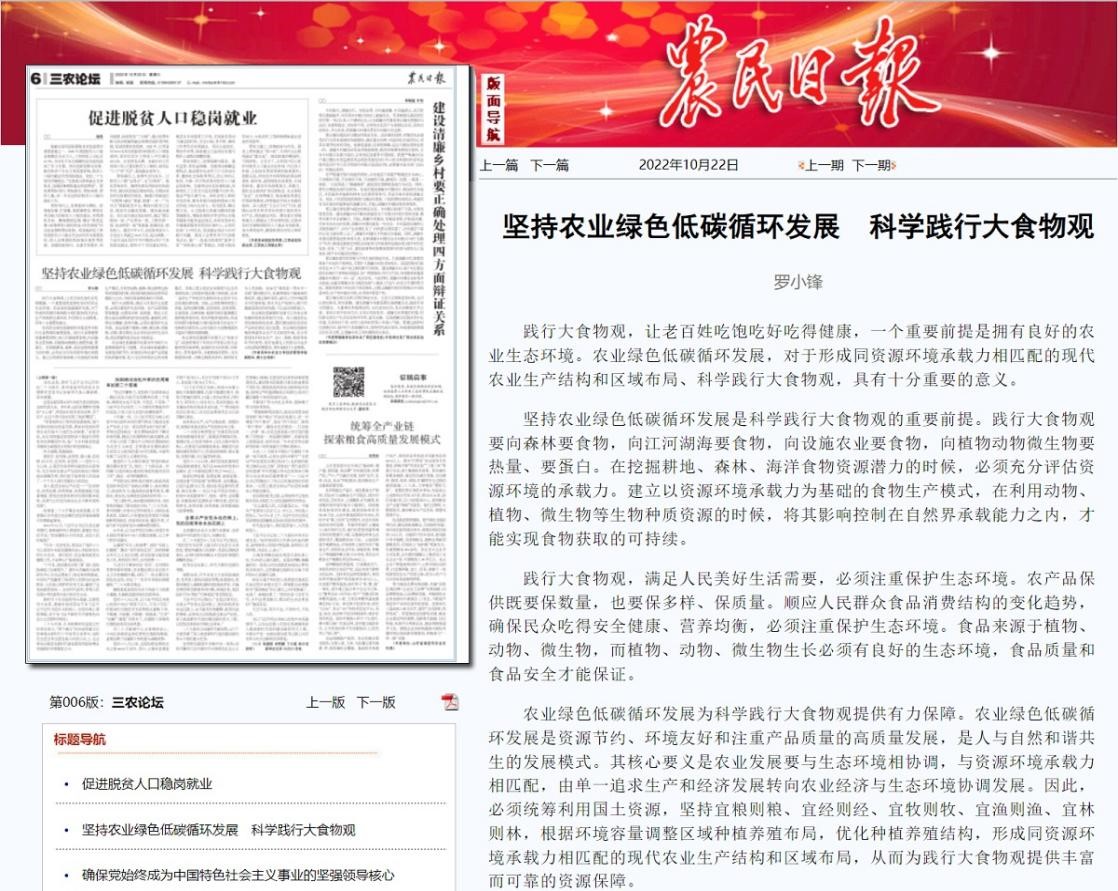
Food security is among a country’s most fundamental interests. With this in mind, President Xi Jinping puts forward the “Greater Food” approach: “While ensuring grain supply, we must also guarantee an effective supply of various foods including meat, vegetables, fruits, and aquatic products.”
A prerequisite for adopting the “Greater Food” concept is to ensure an enabling agricultural ecological environment so that people can eat well and healthily. To achieve green and low-carbon circular development in agriculture, it is important for us to formulate agricultural production structure and regional layout that are in line with the carrying capacity of the resource environment and to adopt the “Greater Food” approach scientifically.
Upholding the green and low-carbon circular development in agriculture is a prerequisite for the scientific adoption of the “Greater Food” approach. We can harvest food from forests, from rivers, lakes, and seas, and from protected agriculture. We can also obtain calories and protein from plants, animals, and microorganisms. The carrying capacity of the resource environment must be fully assessed when we get food from arable land, forests, and seas. Sustainable food acquisition can only be achieved when we establish a food production model based on the carrying capacity of the environment and control the impact of biological germplasm resources such as animals, plants, and microorganisms within the carrying capacity of nature when utilizing such resources.
The ecological environment must be protected if we want to meet people's needs for a better life by adopting the approach. The quantity, diversity, and quality of agricultural products shall be ensured. Environmental protection must be prioritized if we want to ensure a safe, healthy, and balanced food supply for the people which is in line with the changes in their food structure. The ecological environment of plants, animals, and microorganisms that provide us with food must be guaranteed to ensure food quality and food safety.
Achieving green and low-carbon circular development in agriculture helps us better practice the “Greater Food” approach scientifically. It is a high-quality, resource-saving, environment-friendly development model focusing on product quality and harmonious coexistence between man and nature. The key is to achieve harmony between agricultural development and the ecological environment that the carrying capacity of the environment can bear. In other words, it pursues a shift from production and economic development only to the balanced development between the agricultural economy and ecological environment.
Therefore, it is necessary to utilize land and resources in a coordinated way and make use of the water and mountain resources, grow crops, and develop agriculture, industry, or business where conditions permit. According to the environmental capacity, we should adjust the regional planting and breeding layout and optimize the planting and breeding structure. By doing so, we can form a modern agricultural production structure and regional layout that is in line with the carrying capacity of the resources and environment and provide abundant and reliable resources for practicing the approach.
The green and low-carbon circular development in agriculture can “turn waste into treasure”. It can transform waste that is rarely or never utilized into organic fertilizer, feed protein, nutrient base for plants, animals, microorganisms, and food for human. For example, in the “mulberry sticks - black fungus - rice” recycling model, the mulberry sticks, which are normally regarded as waste, can be used as a nutrient base for growing black fungus by recycling. And the residue after the black fungus harvest is an effective organic fertilizer to strengthen farmland fertility.
The green and low-carbon circular development in agriculture can guide the supply-side structural reform in agriculture. To deepen the reform, an increased supply of green and high-quality agricultural products should be prioritized. Green and low-carbon development of agriculture will push the transformation and upgrading of agricultural production methods, give full play to the advantages of green technology in production, processing, marketing, logistics, and more, meet the increasingly diversified food consumption needs of the people, and better practice the “Greater Food” approach.
(The author is Luo Xiaofeng, the vice dean and doctoral supervisor of the College of Economics and Management of HZAU.)
Source: http://news.hzau.edu.cn/2022/1022/64856.shtml
Translated by: Deng Yuxiang
Supervised by: Wang Xiaoyan